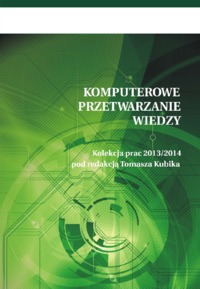496
rezultāti sadaļā
Temats
 Mākslīgais intelekts
Mākslīgais intelekts
Mākslīgais intelekts
Field of computer science that develops and studies intelligent machines
What does thinking mean in the age of Artificial Intelligence? How is big-scale computation transforming the way our brains function? This collection discusses these pressing questions by looking beyond instrumental rationality. Exploring recent developme…
Social robots - robots that are made for interaction with humans - are becoming increasingly popular. In contrast to other disciplines, however, communication research has been slow in studying them. In our view, there are at least three theoretical reaso…
Computers begin, without being aware of it, to effect a major turn in social science technology research: machine technology, having been left for a long time to engineers and environmentalists, arouses the interest of sociologists, too. The paper highlig…
Why could brain utopias from the 1990s be interesting today? Blockbusters such as “Transcendence” with Johnny Depp, whose brain is loaded onto a computer system, or popular Hollywood productions such as “Her,” the series “Real Humans” are recurring on uto…
This paper argues that the hype around ‘ethics’ as panacea for remedying algorithmic discrimination is a smokescreen for carrying on with business as usual. First, it analyses how the current discourses around digital innovation and algorithmic technologi…
Individualization Individuhuman-computer Individu( HCI) culminates in visions like that of Individucompanion-systems They shall transcend the stage of tools and They attendants of their users However or not they are However as such attendants However on t…
The design and evaluation of algorithms for adaptive stochastic control of reservoir function of the water reservoir using artificial intelligence methods (learning fuzzy model and neural networks) are described in this article. This procedure was tested …
This book presents a major leap forward in the understanding of colour by showing how richer descriptions of colour samples can be operationalized in agent-based models. Four different language strategies are explored: the basic colour strategy, the grade…
Περιέχονται ομιλία του Πρωθυπουργού και Προέδρου του ΠΑΣΟΚ Κ. Σημίτη που δόθηκε στους ανθρώπους του Πολιτισμού στο ξενοδοχείο Μ. Βρετάνια στις 14 Σεπτεμβρίου 1996, προσφώνηση κ. Τίτου Πατρίκιου στον Πρωθυπουργό Κώστα Σημίτη και ομιλία του Ζακ Λάνγκ.
Programa d'actualitat amb entrevistes reportatges i debats, presentat per Màxim Castillo i Jordi Corominas; Entrevista a Moisès Jordi, coordinador Limnos, sobre l'automatització de la comporta de desguàs de l'estany de Banyoles. El Temps amb J…
Inauguració del Centre d'Estudis Avançats de Blanes que forma part del Consell Superior d'Investigacions Científiques (CSIC).; 00:00:00 Un grup de persones conversa al vestíbul de l'edifici. 00:00:22 Raimon Obiols (primer secretari del PSC) sa…
The study of complex archaeological systems with the support of the philosophy of Artificial Intelligence is a research project that evaluates the historical meaning of the relationships between archaeological documents, intended as an essentially human c…
This contribution represents a further attempt to synthesise and to introduce the research activities of the Analytical Archaeology and Artificial Adaptive Systems Laboratory (LAA and AAS) recently instituted at La Sapienza University of Rome thanks to th…
In this paper the theoretical and methodological aspects of some of the tools applied to the archaeological, geographical and linguistic problems posed by ARCHEOSEMA project will be analysed. In particular, the single steps of the process of generation of…
For several years now archaeology has made use of methodologies based on Artificial Intelligence (AI) and Artificial Adaptive Systems (AAS). However, there are still only a few experiments that involve the spatial aspect, and in particular spatial analyse…
Methods borrowed from Information Theory are applied to the traditional text criticism. A critique of the raw cladistic methods and an interpretation of the dichotomy-phenomenon are offered. The same methods are applied to 13th century Italian poetry to d…
The paper illustrates how the application of a specific version of Artificial Neural Networks, Self-Organizing Maps (SOMs), enabled a more accurate analysis of human dental morphology. SOMs enable the processing of individual samples (dentitions) because …
The analysis of a corpus of seals belonging to the period of Isin and Larsa, carried out through the use of the Artificial Neural Network Auto-Contractive Maps, allows us to understand the complexity of the relationship of the different elements of the vi…
Two components of the cognitive revolution are here considered in relation to archaeology: first, reflexivity, or in French "la pensée réfléchie", interested in exploration of its own process; second, computer science, which provides a useful fr…
The aim of the project is the design and development of a hypermedia application, exploiting University of Westminster's IDEAs system facilities, with the addition of SGML encoding support. Our target application is based on the Benaki Museum Byzantin…
Artificial neural networks are adaptive models that can be used for classification and pattern recognition purposes. ANNs do not differ from standard statistical models. The main difference between ANNs and traditional statistical models is their construc…
This paper investigates the potential for close methodological synergies between chaîne opératoire and cross-craft interaction, on the one hand, and an alternative use of the so-called process mining in Business Process Modelling, on the other. We use pro…
